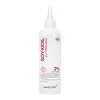What's inside
What's inside
 Key Ingredients
Key Ingredients

No key ingredients
 Benefits
Benefits

 Concerns
Concerns

 Ingredients Side-by-side
Ingredients Side-by-side

Propylene Glycol
HumectantAlcohol Denat.
AntimicrobialMyristyl Alcohol
EmollientBehentrimonium Chloride
PreservativeParfum
MaskingWater
Skin ConditioningButylene Glycol
HumectantGlycerin
HumectantGlycine Soja Germ Extract
Emollient1,2-Hexanediol
Skin ConditioningOryza Sativa Extract
AbsorbentSea Salt
AbrasiveAspergillus Ferment
Skin ConditioningEthylhexylglycerin
Skin ConditioningHydroxypropyltrimonium Hyaluronate
Hydrolyzed Vegetable Protein
Skin ConditioningMaltodextrin
Absorbent3-O-Ethyl Ascorbic Acid
Skin ConditioningBiotin
AntiseborrhoeicHydroxypropyl Cyclodextrin
MaskingCopper Tripeptide-1
Skin Conditioning7-Dehydrocholesterol
Emulsion StabilisingPropylene Glycol, Alcohol Denat., Myristyl Alcohol, Behentrimonium Chloride, Parfum, Water, Butylene Glycol, Glycerin, Glycine Soja Germ Extract, 1,2-Hexanediol, Oryza Sativa Extract, Sea Salt, Aspergillus Ferment, Ethylhexylglycerin, Hydroxypropyltrimonium Hyaluronate, Hydrolyzed Vegetable Protein, Maltodextrin, 3-O-Ethyl Ascorbic Acid, Biotin, Hydroxypropyl Cyclodextrin, Copper Tripeptide-1, 7-Dehydrocholesterol
Water
Skin ConditioningVinegar
Rubus Idaeus Fruit Extract
AstringentRaspberry Seed Oil/Tocopheryl Succinate Aminopropanediol Esters
Skin ConditioningLavandula Angustifolia Extract
Skin ConditioningMelaleuca Alternifolia Leaf Extract
PerfumingRosmarinus Officinalis Leaf Extract
AntimicrobialSaccharomyces Ferment Filtrate
HumectantHydrolyzed Corn Protein
Skin ConditioningHydrolyzed Soy Protein
HumectantHydrolyzed Wheat Protein
Skin ConditioningOctyldodeceth-16
EmulsifyingPEG-60 Hydrogenated Castor Oil
EmulsifyingGlycerin
HumectantButylene Glycol
HumectantCetrimonium Chloride
AntimicrobialCaprylyl Glycol
EmollientPolyquaternium-7
1,2-Hexanediol
Skin ConditioningSodium Citrate
BufferingPentylene Glycol
Skin ConditioningEthylhexylglycerin
Skin ConditioningOctanediol
Alcohol
AntimicrobialDisodium EDTA
Sodium Benzoate
MaskingPhenoxyethanol
PreservativeParfum
MaskingLimonene
PerfumingLinalool
PerfumingHexyl Cinnamal
PerfumingBenzyl Salicylate
PerfumingWater, Vinegar, Rubus Idaeus Fruit Extract, Raspberry Seed Oil/Tocopheryl Succinate Aminopropanediol Esters, Lavandula Angustifolia Extract, Melaleuca Alternifolia Leaf Extract, Rosmarinus Officinalis Leaf Extract, Saccharomyces Ferment Filtrate, Hydrolyzed Corn Protein, Hydrolyzed Soy Protein, Hydrolyzed Wheat Protein, Octyldodeceth-16, PEG-60 Hydrogenated Castor Oil, Glycerin, Butylene Glycol, Cetrimonium Chloride, Caprylyl Glycol, Polyquaternium-7, 1,2-Hexanediol, Sodium Citrate, Pentylene Glycol, Ethylhexylglycerin, Octanediol, Alcohol, Disodium EDTA, Sodium Benzoate, Phenoxyethanol, Parfum, Limonene, Linalool, Hexyl Cinnamal, Benzyl Salicylate
 Reviews
Reviews

Ingredients Explained
These ingredients are found in both products.
Ingredients higher up in an ingredient list are typically present in a larger amount.
1,2-Hexanediol is a synthetic liquid and another multi-functional powerhouse.
It is a:
- Humectant, drawing moisture into the skin
- Emollient, helping to soften skin
- Solvent, dispersing and stabilizing formulas
- Preservative booster, enhancing the antimicrobial activity of other preservatives
Butylene Glycol (or BG) is used within cosmetic products for a few different reasons:
Overall, Butylene Glycol is a safe and well-rounded ingredient that works well with other ingredients.
Though this ingredient works well with most skin types, some people with sensitive skin may experience a reaction such as allergic rashes, closed comedones, or itchiness.
Learn more about Butylene GlycolEthylhexylglycerin (we can't pronounce this either) is commonly used as a preservative and skin softener. It is derived from glyceryl.
You might see Ethylhexylglycerin often paired with other preservatives such as phenoxyethanol. Ethylhexylglycerin has been found to increase the effectiveness of these other preservatives.
Glycerin is already naturally found in your skin. It helps moisturize and protect your skin.
A study from 2016 found glycerin to be more effective as a humectant than AHAs and hyaluronic acid.
As a humectant, it helps the skin stay hydrated by pulling moisture to your skin. The low molecular weight of glycerin allows it to pull moisture into the deeper layers of your skin.
Hydrated skin improves your skin barrier; Your skin barrier helps protect against irritants and bacteria.
Glycerin has also been found to have antimicrobial and antiviral properties. Due to these properties, glycerin is often used in wound and burn treatments.
In cosmetics, glycerin is usually derived from plants such as soybean or palm. However, it can also be sourced from animals, such as tallow or animal fat.
This ingredient is organic, colorless, odorless, and non-toxic.
Glycerin is the name for this ingredient in American English. British English uses Glycerol/Glycerine.
Learn more about GlycerinParfum is a catch-all term for an ingredient or more that is used to give a scent to products.
Also called "fragrance", this ingredient can be a blend of hundreds of chemicals or plant oils. This means every product with "fragrance" or "parfum" in the ingredients list is a different mixture.
For instance, Habanolide is a proprietary trade name for a specific aroma chemical. When used as a fragrance ingredient in cosmetics, most aroma chemicals fall under the broad labeling category of “FRAGRANCE” or “PARFUM” according to EU and US regulations.
The term 'parfum' or 'fragrance' is not regulated in many countries. In many cases, it is up to the brand to define this term.
For instance, many brands choose to label themselves as "fragrance-free" because they are not using synthetic fragrances. However, their products may still contain ingredients such as essential oils that are considered a fragrance by INCI standards.
One example is Calendula flower extract. Calendula is an essential oil that still imparts a scent or 'fragrance'.
Depending on the blend, the ingredients in the mixture can cause allergies and sensitivities on the skin. Some ingredients that are known EU allergens include linalool and citronellol.
Parfum can also be used to mask or cover an unpleasant scent.
The bottom line is: not all fragrances/parfum/ingredients are created equally. If you are worried about fragrances, we recommend taking a closer look at an ingredient. And of course, we always recommend speaking with a professional.
Learn more about ParfumWater. It's the most common cosmetic ingredient of all. You'll usually see it at the top of ingredient lists, meaning that it makes up the largest part of the product.
So why is it so popular? Water most often acts as a solvent - this means that it helps dissolve other ingredients into the formulation.
You'll also recognize water as that liquid we all need to stay alive. If you see this, drink a glass of water. Stay hydrated!
Learn more about Water